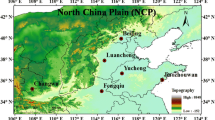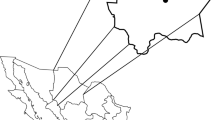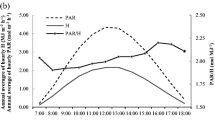Abstract
Photosynthetically active radiation (PAR) as a component of solar radiation plays a major role in different applications dealing with plant canopies, biomass production and microalgae growth. The amount of PAR energy depends upon location, time of the year and atmospheric conditions. Understanding the PAR and its availability is very essential for modelling biological growth system. The objective of this study is to estimate PAR for latitudes ranging from 9° to 34° and for the entire year based on hourly and monthly average of the daily global radiation (Hg). Based on the estimated data, a power regression model showing the relationship between PAR and Hg is presented for six Indian latitudes. The ratios of hourly sum of PAR to Hg and monthly average of hourly global radiations (Ig) vary smoothly with significant seasonal variations and are influenced by several other local climatic conditions. The power regression equation between PAR and Hg obtained are as follows: (a) For 9° latitude, PAR = 0.040 (Hg)0.924, R2 = 0.970, (b) 14° latitude, PAR = 0.029 (Hg)0.952, R2 = 0.894, (c) 19° latitude, PAR = 0.256 (Hg)0.748, R2 = 0.721, (d) 24° latitude, PAR = 0.159 (Hg)0.775, R2 = 0.896, (e) 29° latitude, PAR = 0.052 (Hg)0.886, R2 = 0.830 and (f) 34° latitude, PAR = 0.016 (Hg)1.013, R2 = 0.768.
Similar content being viewed by others
Avoid common mistakes on your manuscript.
Background
The amount of solar radiation reaching the top of the Earth's atmosphere is around 1,367 W m−2, also called as solar constant [1]. On a bright sunny day, roughly around 800 to 1,200 W m−2 of total radiation reaches the Earth's surface owing to atmospheric scattering and absorption. The sun radiates energy in the spectral range from 280 to 4,000 nm (Figure 1), with a maximum in the blue-green (480 nm). The three major regions of the solar spectrum are (a) ultraviolet region (wavelength less than 400 nm): constitutes 9% of the irradiance, (b) visible region (wavelength ranging from 400 to 700 nm): constitutes 45% of the irradiance and (c) infrared region (wavelength greater than 700 nm): constitutes 46% of the irradiance.
The photosynthetically active radiation (PAR) in visible spectrum ranging from 400 to 700 nm is absorbed by plants to carry out photosynthesis. The PAR provides energy for photosynthesis and regulates plant growth and development. Within the PAR, the solar radiation peaks at 590 nm. The amount of PAR highly depends on environmental conditions. The measurement of the PAR is very important for environmental systems, agriculture, forest, architecture, solar greenhouse and many other applications. The PAR estimation based on simple methodologies would be highly useful for ecological modelling, algal photosynthesis, plant yield and land use efficiency. Therefore, a simple regression model that accurately predicts the PAR from global irradiance is necessary to design the growth system of phototropic microorganism.
The energy generation from solar radiation and performance correlations has been investigated by many authors [2]–[6]. The estimation of PAR based on solar global radiation has been studied by different authors for various specific locations [7]–[12]. The theoretical background and applications of PAR are described by [13]. Relatively, very little information regarding the availability of PAR in Indian context has been published in literature. Considering that the PAR measurement is very scarce in India, it becomes more necessary to estimate PAR based on global solar radiation as a function of local climatic condition. The most probable idealised conversion coefficient (PAR/Total global solar radiation, μmol J−1) of 1.814 has been reported [13].
The objective of this study is to estimate PAR based on hourly average and daily average of monthly solar radiation for the Indian latitudes ranging from 9° to 34°. This study is initiated to develop a simpler approach for estimating and validating the PAR and provide monthly estimates of solar radiation that can be used as input for biological growth model.
The specific activities of this study are as follows: to predict the monthly and daily average of global solar radiation, to estimate the daily average PAR at various Indian latitudes, and to evaluate the correlation between estimated monthly average of hourly global radiation and the PAR radiation at the Earth's surface based on regression model.
Methods
PAR modelling
The characteristics of studied location
India lies to the north of the equator between 6°44' and 37°30' north latitude and 68°7' and 97°25' east longitude. The Indian subcontinent undergoes four major climatic seasons when every season is about 2 months. These are winter (January to February), summer (March to May), a monsoon (rainy) season (June to September) and a post-monsoon season (October to December). Various climatic factors are responsible for the seasonal changes in India.
Estimation of daily average of monthly horizontal global radiation
The extraterrestrial solar radiation incident on a horizontal surface can be determined for any location and day of the year according to previous researchers [14, 15]. Solar declination angle can be calculated for each day based on the Cooper equation. It varies throughout the year and is the function of the day number of the year (N) as shown in Table 1. N ranges from 1 to 365.
The solar hour angle for a location on Earth is zero when the sun is directly overhead, negative before noon and positive in the afternoon. The solar hour varies from 1 to 24.
The sunrise hour angle for a location is a function of solar declination angle and the latitude.
The total daily average extraterrestrial radiation incident on Earth varies seasonally due to the atmospheric transmissivity associated with cloud cover.
Isc is called as solar constant which is roughly equal to 1,367 W m−2.
Estimation of hourly average of monthly horizontal global radiation
The hourly extraterrestrial radiation on a horizontal surface is obtained from the following expression:
The empirical constants by regression parameters for a particular location were obtained by the fitting data:
Estimation of photosynthetically active global radiation
The PAR (μmol m−2 s−1) is a function of various solar angles and the total global solar radiation. The total PAR over a horizontal surface can be determined from the monthly average hourly radiation directly by utilising the following expression [17]:
Equations 1, 2, 3, 4, 5, 6, 7 and 8 were solved in MATLAB (MathWorks, Inc., Natick, MA, USA) to find the PAR at any given latitude and day. MATLAB program calculates the values of the PAR by substituting values of N ranging from 17 to 344 in Equation 1.
Results
Variation of daily average of monthly extraterrestrial global solar radiations
The methodology proposed in Equations 1, 2, 3, 4, 5, 6, 7 and 8 has been used to estimate the hourly and daily average of monthly global solar radiation on a horizontal surface as a function of position and location. By knowing the hourly average of monthly global solar radiation data on the horizontal surface, the corresponding average PAR can be determined. Tables 2, 3, 4, 5, 6 and 7 show the estimated declination angle, monthly average of the daily values of global radiation, monthly average of the hourly values of global radiation and the PAR for Indian latitudes. The values obtained for 34° latitude are the lowest and ranged from 16,938 to 4,129.9 kJ m−2 day−1 as shown in Table 7. The total annual average global solar radiation is highest for 14° latitude (35,958 kJ m−2 day−1), and 34° latitude has the lowest value of (18,738 kJ m−2 day−1) as shown in Table 8. The results obtained for the studied locations show that irradiance profile is quite similar. The daily global variations for all the latitude are also analogous. It is observed that the estimated daily global radiation results are in close agreement with the other literature data [16].
Variation of the PAR
The observed values of the PAR across the six locations have means of 621.9093, 656.5131, 604.1243, 436.4398, 557.8364 and 377.8203 μmol m−2 s−1, respectively. The annual average values of PAR, Hg, Ig and irradiance are shown in Table 8. It is observed that 34° latitude has the lowest value of irradiance and PAR. The seasonal and location-specific variation of the PAR is clearly evident from the data presented in Tables 2, 3, 4, 5, 6 and 7. These data show the availability of PAR at a specific latitude that is highly useful for locating an open pond algae cultivation system that transmits sufficient PAR to produce a higher biomass yield. However, low disperse irradiance level results in higher photosynthetic efficiency of plants and microorganisms when their cells are growing under irradiance level far from saturation. The analysis of solar radiation performed in this paper suggests that 34° latitude is the best option for large-scale microalgal cultivation because of the fact that microalgae requires light intensity below 400 μmol m−2 s−1 for optimum growth [17].
Regression model
Regression analyses between the PAR and the monthly average of daily global solar radiation are carried out for each latitude. A power regression in the form y = C(x)n was chosen. The graphs of the PAR against daily average global irradiance are plotted for various locations (Figures 2, 3, 4, 5, 6 and 7). The statistic performance of power regression equation to calculate the PAR for each latitude is shown in Table 9.
The power regression model provides estimates with some degree of correlation between the PAR and Hg. The estimated results are correlated for various latitudes in the following manner: 9° (R2 = 0.931), 14° (R2 = 0.829), 19° (R2 = 0.721), 24° (R2 = 0.766), 29° (R2 = 0.830) and 34° (R2 = 0.768). The power regression analysis between the estimated PAR and the Hg values shows a strong correlation for 9° latitude. A weaker correlation is observed for the rest of the latitudes. On the other hand, the spreading of these differences is higher at higher latitudes. The results for the PAR model suggest that the PAR could be estimated with an average level of confidence using global irradiance as a parameter .This suggests that the PAR values obtained from the analysis present a greater local dependency of climatic conditions and show marked differences. The proposed estimation scheme tries to highlight the necessity of local and seasonal calibration of the PAR/Hg ratio. Nevertheless, considering the differences in climatic conditions, it is possible that some differences exist in the correlation applicable to these different latitudes. This proves that there are marked tendencies to overestimate or underestimate the range of the PAR for other latitudes.
Discussion
PAR must be determined for applications related to microalgae growth, biomass yield, natural lighting and greenhouse design. The feasibility of microalgal cultivation system at a given location is greatly dependent on the availability of photosynthetically active component of natural sunlight. The models developed for this study were able to estimate PAR for a given day, latitude, surface and atmospheric conditions using MATLAB. This study is done to develop a simpler approach for estimating and validating the PAR . This can be used to provide rough estimates of hourly, daily, monthly and yearly global solar radiation. It is also evident that the annual average PAR can lie between 621 and 377 μmol m−2 s−1 which is close to established literature values [7]–[12]. With the relationships among irradiance, the PAR was examined using regression model. The results are used to determine if regression relationships differed significantly. For the 9° latitude data set, it is found that the power regression models provide better estimates. The estimates of PAR obtained through this method could be improved through actual ground measurements. The results of this model can be easily connected to biological process models for plant growth modelling and feasible design of algae cultivation system.
Conclusions
This study is a step towards modelling and estimation of PAR for a geographic location and day of the year. It takes into account the various solar angles, cloudiness, weather conditions and relates them to the global irradiance. The variation in the PAR during the whole year for various latitudes ranging from 9° to 34° geographical locations is quantified. The paper is the first attempt to quantify the PAR for various Indian latitudes; thus, the results can be used to obtain the important PAR values for similar conditions where Hg data are available. The performance of this method to estimate monthly average of hourly and daily global solar radiation is verified and validated with the other literature models. This approach represents a new opportunity to estimate the PAR for any location inside the study area. This could be particularly useful for designing algae cultivation system for optimising the PAR energy utilisation for maximum yield.
Authors' information
KS is an assistant professor in the Department of Energy at Maulana National Institute of Technology, Bhopal. His research interests are algae photosynthesis, biofuels, solar thermal and PV, solar energy modelling, climate change and carbon sequestration. MP is an associate professor in Centre for Energy and Environmental Science and Technology at the National Institute of Technology, Tiruchirappalli. Her research interests are energy conservation, carbon sequestration treatment, energy modelling and simulation. TS and GS are M. Tech. scholars at the Energy Centre, Maulana National Institute of Technology, Bhopal.
Abbreviations
- a:
-
b: empirical constants by regression parameters for a particular location, obtained by fitting data
- del:
-
declination angle (degrees)
- Hg:
-
monthly average of daily global radiations on a horizontal surface (kJ m−2 day−1)
- Ig:
-
monthly average of hourly global radiations on a horizontal surface (kJ m−2 h−1)
- Isc:
-
solar constant (W m−2)
- lat:
-
latitude (degrees)
- LST:
-
local solar time (minutes)
- N:
-
day number of the year
- PAR:
-
photosynthetically active radiation (μmol m−2 s−1)
- ωs:
-
solar angle (degrees)
- ω:
-
solar hour angle (degrees).
References
Iqbal M: An Introduction to Solar Radiation. Toronto: Academic Press; 1983.
Siddiqui R, Bajpai U: Correlation between thicknesses of dust collected on photovoltaic module and difference in efficiencies in composite climate. Int. J. Energy Env. Eng. 2013, 3(26):1–7.
Sharma P, Harinarayana T: Enhancement of energy generation from two layer solar panels. Int. J. Energy Env. Eng. 2012, 3(12):1–9.
Kandasamy S, Vellingiri M, Sengottain S, Balasundaram J: Performance correlation for single-basin double-slope solar still. Int. J. Energy Env. Eng. 2013, 4(4):1–6.
Panchal H, Shah PK: Investigation on solar stills having floating plates. Int. J. Energy Env. Eng. 2012, 3(8):1–5.
Oyedepo S: Efficient energy utilization as a tool for sustainable development in Nigeria. Int. J. Energy Env. Eng. 2012, 3: 11–22. 10.1186/2251-6832-3-11
Papaioannou G, Papanikolaou N, Retails D: Relationships of photosynthetically active radiation and shortwave irradiance. Theor. Appl. Climatol. 1993, 48: 23–27. 10.1007/BF00864910
Alados I, Foyo-Moreno I, Alados-Arboledas L: Photosynthetically active radiation: measurements and modelling. Agric. For. Meteorol. 1996, 78: 121–131. 10.1016/0168-1923(95)02245-7
Zhou Y, Xiang Y, Luan L: Climatological estimation of photosynthetically active quantum flux. Acta meteorologica sinica 1996, 54: 447–454.
Nojd P, Hari P: Instantaneous PAR estimated using long records of daily temperature and rainfall. Agric. For. Meteorol. 2001, 109: 47–59. 10.1016/S0168-1923(01)00258-1
Tsubo M, Walker S: A model of radiation interception and use by a maize-bean intercrop canopy. Agric. For. Meteorol. 2002, 110: 203–215. 10.1016/S0168-1923(01)00287-8
Jacovides CP, Timvios FS, Papaioannou G, Asimakopoulos DN, Theofilou CM: Ratio of PAR to broadband solar radiation measured in Cyprus. Agric. For. Meteorol. 2004, 121: 135–140. 10.1016/j.agrformet.2003.10.001
Ritchie RJ: Modelling photosynthetic photon flux density and maximum potential gross photosynthesis. Photosynthetica 2010, 48: 596–609. 10.1007/s11099-010-0077-5
Duffie JA, Beckman WA: Solar engineering of thermal processes. New York: Wiley; 1980.
Liu BYH, Jordan RC: The interrelationship and characteristic distribution of direct, diffuse and total solar radiation. Sol. Energy 1968, 7: 53–65.
Klein SA: Calculation of monthly average insolation on titled surfaces. Sol. Energy 1997, 19: 325.
Molina Grima E, Fernandez FGA, Camacho FG, Chisti Y: Photobioreactors: light regime, mass transfer, and scale up. J. Biotechnol. 1999, 70: 231–247. 10.1016/S0168-1656(99)00078-4
Acknowledgements
The authors are grateful to the Director of the Maulana National Institute of Technology Bhopal, MP and to the director of the National Institute of Technology Tiruchirappalli, Tamilnadu.
Author information
Authors and Affiliations
Corresponding author
Additional information
Competing interests
The authors declare that they have no competing interests.
Authors' contributions
MP gave guidance to KS who carried out the PAR modelling and drafted the manuscript. TS compiled them into a journal format. GS went through the text of the paper and critically checked the correlation for correctness. All authors read and approved the final manuscript.
Authors’ original submitted files for images
Below are the links to the authors’ original submitted files for images.
Rights and permissions
Open Access This article is distributed under the terms of the Creative Commons Attribution 2.0 International License (https://creativecommons.org/licenses/by/2.0), which permits unrestricted use, distribution, and reproduction in any medium, provided the original work is properly cited.
About this article
Cite this article
Sudhakar, K., Srivastava, T., Satpathy, G. et al. Modelling and estimation of photosynthetically active incident radiation based on global irradiance in Indian latitudes. Int J Energy Environ Eng 4, 21 (2013). https://doi.org/10.1186/2251-6832-4-21
Received:
Accepted:
Published:
DOI: https://doi.org/10.1186/2251-6832-4-21











